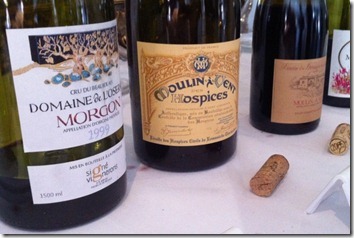One way of dealing with the overwhelming complexity of the world of wine is to decide that there certain wines/grapes/styles that you don’t like. A few popular favourites would be a) German wine (sweet and flavourless) b) English wine (how could you? see previous post) c) over-oaked Chardonnay (agreed). My number one choice would be – or would have been – the Gamay grape and therefore all things Beaujolais: light, inconsequential, fruity in a vaguely vegetal way, often reeking of bubble gum (due to a wine making technique known as carbonic maceration). But I now have to give up this prejudice having been to the Beaujolais tasting put on by Inter Beaujolais to show the 2011 vintage …
The problem is quite simple – ignorance. We think of Beaujolais as a light and cheap wine, best drunk chilled when the main thing is the picnic, the party, the night out. Many of these examples do conform to the stereotype above. But there is then another tier to the world of Gamay in its home territory: the world of Beaujolais-Villages and the ten villages which have crus of their own. Here serious wines are made in the £10-15 bracket from old bush vines with low yields. They are true representatives of the granite soils from which they come. Yes, they are light and fragrant in the main, but that is not a fault – compare Pinot Noir. They also have a decent depth of fruit, some complexity, good acidity and grippy tannins. They are real red wines.
A widely available wine is from the appellation Brouilly, Henry Fessy, 2011, £10 from Waitrose, showing bright cherry fruit, light tannins and a good fruity finish. It would compare very well with a light Cabernet Franc from the Loire or the same quality Valpolicella from the Veneto. But almost any of the Beaujolais crus can also produce a denser, more structured wine too. Berry Bros have AC Côtes de Brouilly, Les Sept Vignes, Ch. Thivin, 2011 with a moderately perfumed nose and classy fruit on the palate, cherry and blueberry. Old vines can also play their part: AC Morgon, Vielles Vignes, Jean-Paul Thévenet 2011 has a good level of complexity on the nose and then structure and length on the palate – with cherry fruit moving into cherry stone and mineral notes.
 But the real surprise was the final table with wines from older vintages – and yes we are talking about Beaujolais here. From the excellent 2005 vintage there was a ‘simple’ AC Beaujolais Villages, Quintessence de Gamay, Domaine des Nugues. It starts like old Burgundy with a healthy whiff of farmyard and then reveals rich mulberry fruit on a well structured palate. The tannins are still very much present but now are smooth and sleek. Ch. de Fleurie 2005 looked like old Pinot Noir with its pale elegant garnet and showed modest if beautiful old fruit notes. And what about a 12 year old in magnum? AC Morgon, Dom. del l’Oseraie 1999 opens with a volatile, acetic aroma but then has subtle red fruit, with the same combination on the palate – clearly ageing but gracefully and highly drinkable. We treasure other reds which show signs of ageing, so why not top quality Beaujolais? And from now on I will have to take Gamay seriously, as well as enjoying its quaffing qualities.
But the real surprise was the final table with wines from older vintages – and yes we are talking about Beaujolais here. From the excellent 2005 vintage there was a ‘simple’ AC Beaujolais Villages, Quintessence de Gamay, Domaine des Nugues. It starts like old Burgundy with a healthy whiff of farmyard and then reveals rich mulberry fruit on a well structured palate. The tannins are still very much present but now are smooth and sleek. Ch. de Fleurie 2005 looked like old Pinot Noir with its pale elegant garnet and showed modest if beautiful old fruit notes. And what about a 12 year old in magnum? AC Morgon, Dom. del l’Oseraie 1999 opens with a volatile, acetic aroma but then has subtle red fruit, with the same combination on the palate – clearly ageing but gracefully and highly drinkable. We treasure other reds which show signs of ageing, so why not top quality Beaujolais? And from now on I will have to take Gamay seriously, as well as enjoying its quaffing qualities.


Comments are closed.